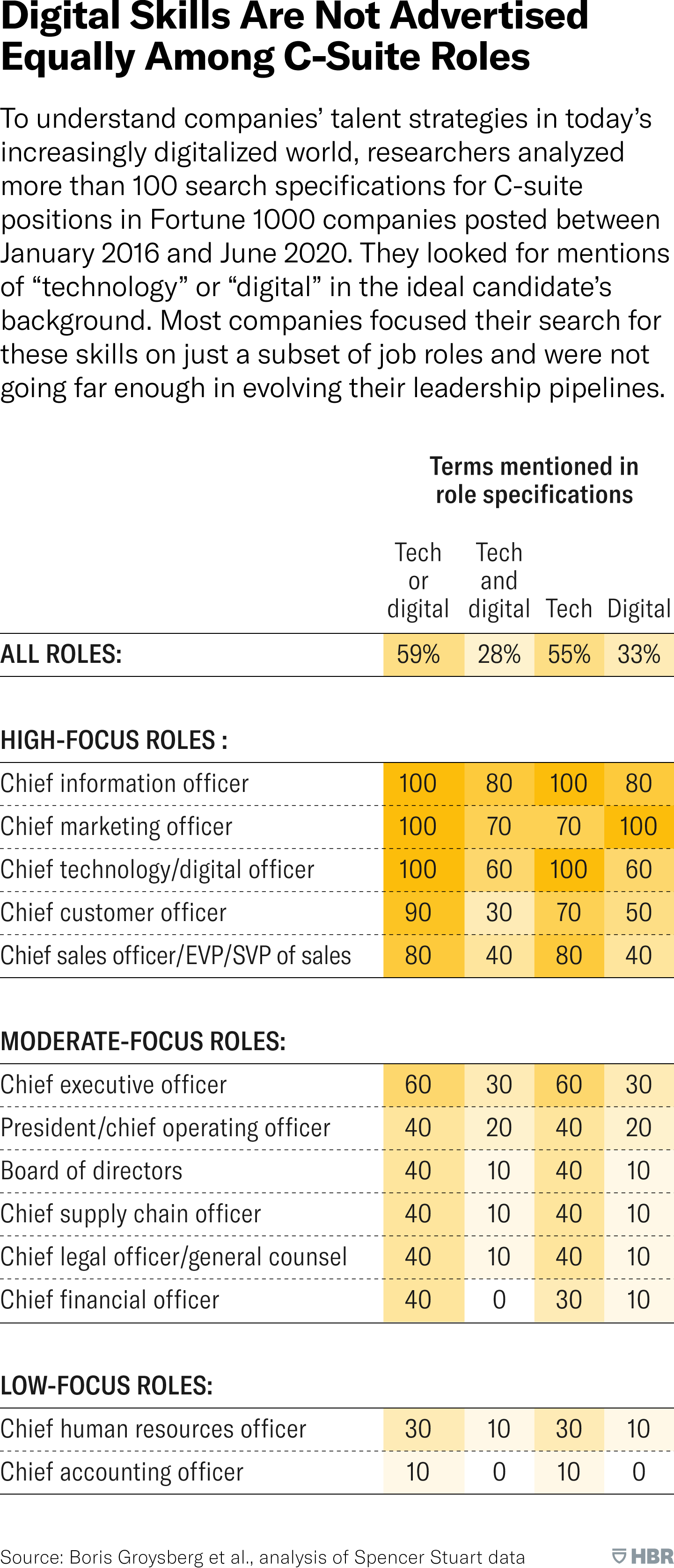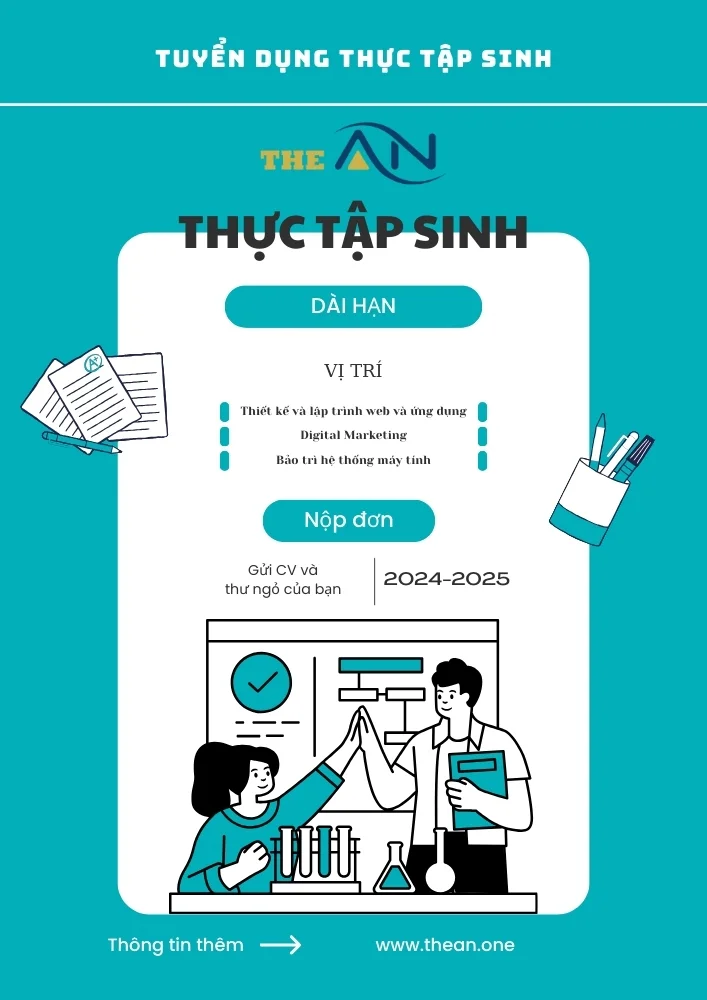Is Your C-Suite Equipped to Lead a Digital Transformation?

by J. Yo-Jud Cheng, Cassandra Frangos, and Boris Groysberg
Summary. The pandemic has rapidly accelerated many companies’ digital efforts, but do they have the right executives in place to lead this sort of transformation? To answer this question, the authors analyzed more than 100 search specifications for C-suite positions in Fortune 1000 companies across a broad range of industries. They identify how C-suite roles are changing, what companies can do to close the digital skills gap, and how individuals, including CEOs, board members, and up-and-coming professionals, can prepare themselves for future success.
The Covid-19 pandemic dramatically accelerated technology adoption across all industries. According to one survey, 77% of CEOs reported that the pandemic sped up their companies’ digital transformation plans, and as Microsoft CEO Satya Nadella noted in the early days of the crisis, “We’ve seen two years’ worth of digital transformation in two months.” A study conducted by Twilio found that Covid-19 accelerated companies’ digital communications strategies by an average of six years.
Historically, success rates for digital transformation efforts are dismally low. Many organizations rush to boost headcount and budget, hiring teams of talented engineers, data scientists, and cybersecurity experts.
But to truly succeed transformation also needs to happen at the very top – with the individuals who set strategy and allocate resources. Take Domino’s, for example. In a mature and competitive industry, the company moved its stock price from $3 in 2008 to a high of $433 in 2020 because an integrated, digitally savvy top management team created a strategy that used data-driven experiments and decisions to redesign delivery routing systems, integrate ordering systems into a myriad of platforms (including text and smart TVs), and modernize every facet of the company.
In our experience, long-held processes and norms for selecting top executives are notoriously slow to change. Financial literacy is a baseline qualification for any top executive; we need to think about technological and digital literacy in the same way. These capabilities that used to be nice-to-haves are now must-haves: Companies can’t afford to have an executive who might confuse discussions about the cloud with small talk about the weather.
Do today’s top teams have the skills to undertake a true digital transformation? To answer this question, we conducted an analysis of more than 100 search specifications for C-suite positions in Fortune 1000 companies across a broad range of industries. (These listings were posted between January 2016 and June 2020. More on the methodology below.)
We found that the search for tech and digital expertise has been on the rise since well before the pandemic: 59% of the searches included technological and/or digital expertise. (Tech is a broad term that typically encompasses technological techniques, skills, systems, processes, hardware, and software. Digital can be thought of as a subset of technology, typically referring to intangibles rather than physical assets.)
Companies sought these skills across a wide variety of roles, suggesting that many had already filled key leadership roles with the right people ahead of the pandemic, but some job roles were neglected in the search for technological and digital expertise. Not surprisingly, 100% of the specs we analyzed for chief information officers, chief marketing officers, and chief technology officers sought technological and/or digital skills. But fewer than a third of the specs for chief human resource officers and chief accounting officers mentioned these skills. Falling in between — at 40-60% — were searches for roles such as CEO, board director, and chief financial officer.

How Roles Have Evolved
Based on our study of search specs, most companies focused on just a subset of job roles in their digital transformation efforts, indicating that many had not been taking a broad enough approach in revamping their talent strategy. Successfully navigating this digital acceleration requires a shift and expansion of responsibilities across all roles throughout the organization.
Chief Technology Officer
In the past, CTOs were the resident experts in the opportunities and limitations presented by new technologies. Now, CTOs are being called upon to lead company-wide digital transformations. They not only need to formulate new digital strategies — identifying areas where value can be created through linkages between new technologies and the rest of the business — but equally important, they play a central role in motivating and aligning fellow employees to embrace these new initiatives and technologies. They serve as champions in building a culture that supports technology-driven strategic imperatives.
Chief Marketing Officer
CMOs have traditionally focused on developing and implementing their organizations’ overall marketing strategy. This encompassed market research, pricing decisions, advertising strategy, and public relations. Now, CMOs must forecast future developments and adapt their strategies to contend with the ongoing evolution away from mass marketing and toward increasingly targeted and data-driven marketing. Internally, CMOs need to implement technological systems to track KPIs in real time, automate reports, and accelerate decision-making. Externally, the rapid proliferation of communication platforms and online direct distribution channels makes it imperative for CMOs to ensure consistency in messaging across channels and to grapple with constant, immediate feedback from being under the “social media microscope.”
Chief Executive Officer
The CEO has long been in charge of setting and directing company strategy, making major corporate decisions, leading the vision and culture of the organization, and serving as the public face of the company. CEOs today need to manage this hefty set of responsibilities within the context of a rapidly changing landscape. They need to develop new business targets and goals and ensure alignment between functional areas and relevant stakeholders. And when a large-scale digital transformation is needed, success will hinge on the CEO’s ability to articulate the case for change, communicate a forward-looking strategy both within the firm and to external constituents, and role model a culture that can drive the transformation.
Board of Directors
Traditional responsibilities for boards include oversight of regulatory and compliance issues, monitoring financial statements, advising on company strategy, setting CEO compensation, hiring and firing the CEO, and nominating new directors. Now, the board’s responsibilities are expanding to hold management accountable to a wider range of goals and targets that involve long-term innovation and investment, not just short-term financial performance. In today’s world, the need for a digitally savvy board isn’t just about taking advantage of future opportunities; it is also about mitigating new sources of risk. A board with directors who are technologically sophisticated will better prepare the firm for long-term success by being able to effectively advise on technological investments, select the right CEO for future needs, and manage their own learning and refreshment through new director recruitment and training sessions as needed.
Chief Financial Officer
The CFO’s customary responsibilities include financial forecasting, budgeting, and reporting, defining P&L investment plans, and managing shareholder activism and investor relations. Now, successful CFOs must also leverage new technologies to automate and streamline financial reporting processes and analyses. They need to maintain a progressive outlook when forecasting in an environment where revenue streams and cost structures are fundamentally changing. As the gatekeepers of much of the data needed for strategic planning and analysis, CFOs can play a central role in evaluating the costs and benefits of technological investments, and in identifying new growth areas and other opportunities for the entire firm.
Chief Human Resources Officer
For years, standout CHROs articulated and executed a people agenda that aligned with the business strategy. They are also currently playing a key role in the future of work and future talent strategies. Although tech and digital expertise is not a primary focus in many CHRO searches, today’s forward-thinking CHROs are increasingly taking HR systems online and facilitating greater employee self-service capabilities. They’re implementing HR data analytics systems and finding ways to leverage data in their talent management strategy. A major challenge moving forward will be the recruitment and retention of individuals with critical technological and digital skills, and managing the internal talent pipeline in light of technological advancements. At their best, CHROs serve as a partner in change initiatives and culture transformations to foster innovation and agility.
Filling the Skills Gap
This dramatic shift in job responsibilities is creating a skills gap in many companies’ leadership pipelines that necessitates major changes to talent strategy. To find the right candidates, companies may need to rethink traditional promotion pathways. For example, rather than promoting the president or COO when selecting a new CEO, the search for a digitally savvy CEO might mean appointing a candidate from further down in the organizational hierarchy (a phenomenon called “CEO leapfrogging”). We’ve already witnessed this with Microsoft’s Satya Nadella and Cisco’s Chuck Robbins, who were selected, in part, for their visions of how technology will be used in the future. Nadella rose up through Microsoft’s cloud and enterprise group, helping him chart Microsoft’s evolution away from its traditional business products and into services. Robbins was promoted from head of sales to CEO. While sales is not typically thought of as a training ground for tech and digital expertise, this role helped him stay on top of new trends through close relationships with customers.
Job rotations can also play an important role in building a robust, future-ready leadership pipeline. Although operational roles are traditionally thought of as stepping stones to the highest corporate echelons, today’s high potentials can benefit not just from rotations through jobs with P&L responsibilities, but also through tech functions. In the past, rotations into tech roles often left executives thinking, “Why am I being punished?” But IT is much more than just a support function; now, these roles can provide critical skills and experiences for leading into the future.
When the right candidates don’t exist in-house, companies will need to turn to the external labor market. But they’ll need to prepare to pay a premium; individuals with tech and digital skills are in-demand by many companies. This trend also has implications for firms with longstanding strengths in technology, which may find themselves being raided for talent. Companies will need to take proactive steps to retain their top employees.
We see a similar skills gap emerging in boardrooms. In a global survey we conducted of board directors, more than a third of respondents indicated that they personally struggle to stay on top of risk and security issues and new technologies. Further, just 13% of boards sought technological expertise with their most recent director search. In the words of one survey respondent, this has resulted in “an over-emphasis and over-abundance of directors with financial and general management skills.” Board turnover is typically low and staggered board terms mean that changes to board composition take a long time. Boards need to rethink ingrained norms around board tenure and also spend time on training and learning opportunities for current board members as they adapt to the business environment.
Preparing Yourself for Future Success
We think the next few years will see a revolution for many top management roles. The pandemic has exposed the executives who were not up to the challenge of a rapid technological pivot. In some cases, it has become clear that the wrong leaders are in place, and the only thing standing in the way of replacement is the lack of a suitable successor. Once boards and top teams have time to search for new candidates and more candidates are unleashed into the external market after annual bonuses are disbursed, we will likely see tremendous amounts of turnover and a very turbulent environment that will highlight the chasm between the digitally savvy haves and the traditional have-nots.
As the need for technological skills become more pressing, what can you do to stay current? We offer the following advice.
For CEOs
- You don’t need to think of yourself as the expert on the leading edge. Having both the requisite leadership abilities and being at the forefront of technical proficiency is quite rare. Instead, endeavor to build the domain knowledge needed to lead organizational change, align the top team around a clear strategy, and ensure coherence across functional areas and work groups.
- Culture is an important facet of any change initiative and cannot be neglected. You play an important role in leading an innovative and creative culture that can reinforce technology-driven strategic shifts.
- Surround yourself with the right team: Identify people in the organization that have vital expertise, create a seat for them around the table, and ensure that their voices are heard. You might need to change organizational structure to fully execute on your digital transformation.
- On the other side of the coin, you might also need to make painful decisions about switching out other roles if current executives and managers are not prepared for what’s to come. One study found that 70% of digital transformation efforts do not achieve their objectives and managerial resistance is a leading reason. If leaders cannot get on board, it may be time for them to go.
For senior leaders and board members
- Always strive to stay relevant, learn, and adapt – continuously developing skills is critical to avoid falling behind.
- Consider how you can adopt a data-driven approach to all of the work you do. Things that have helped you succeed in the past may not be the best way any longer. Work to remain open-minded about how things are done. Resistance to new ways of working is a major barrier to companies reaching their full digital potential.
- Learn from the people who are ahead and the people who are behind you (“reverse mentoring”). There is much to learn from the people who are closest to new technologies and customers.
- Staying up-to-date on technological trends is critical in inspiring your team’s confidence and respect in you. If you lose their trust in your capabilities, they will choose to leave, or may even replace you.
For up-and-coming professionals
- Seek out development and rotation opportunities to build out your existing digital and leadership capabilities, and be willing to take lateral moves to develop new ones. Even if these changes do not provide an immediate promotion, they will offer valuable experience that will round out your qualifications. (Many compelling candidates have experience in multiple disciplines, with career trajectories that are non-linear and involve shifts and stints across different industries and functions.)
- Carefully consider the types of companies you work for. The company you are associated with will define your brand. People will make inferences about your tech savviness based on your firm, even before looking at your specific qualifications. (For example, a software company looking for a new COO with software experience centered their search around executives from other software companies, frequently ruling out candidates from hardware companies, even before looking at their qualifications.)
- Become an architect of your own portfolio of experiences: This could be at one company or across multiple companies. Be mindful that the career steps taken by mentors and other senior executives may no longer be the way up the corporate hierarchy in today’s evolving world.
Covid-19 moved tech from the periphery into the center, and it is here to stay. Although tech and digital trends do not uniformly affect all jobs today, we believe it is only a matter of time before these skills become baseline qualifications across the board. Investing in these skills now will enhance your marketability and prepare you for the realities of our evolving business world.
J. Yo-Jud Cheng is an Assistant Professor of Business Administration in the Strategy, Ethics and Entrepreneurship area at Darden.
Cassandra Frangos is a member of the Leadership Advisory Services and CEO practices at Spencer Stuart, the executive search and leadership advisory firm, and the author of Crack the C-Suite Code: How Successful Leaders Make It to the Top.
Boris Groysberg is the Richard P. Chapman Professor of Business Administration at Harvard Business School, a faculty affiliate at the HBS Gender Initiative, and the coauthor, with Colleen Ammerman, of Glass Half-Broken: Shattering the Barriers That Still Hold Women Back at Work (Harvard Business Review Press, 2021).
Source: Harvard Business Review
Image Source: Westend61/Getty Images
Looking for a custom web design? Then Contact the website designers at The ÂN in Vietnam via (+84).326.418.478 (phone, zalo, viber) or schedule a consultation.
Other useful information:









